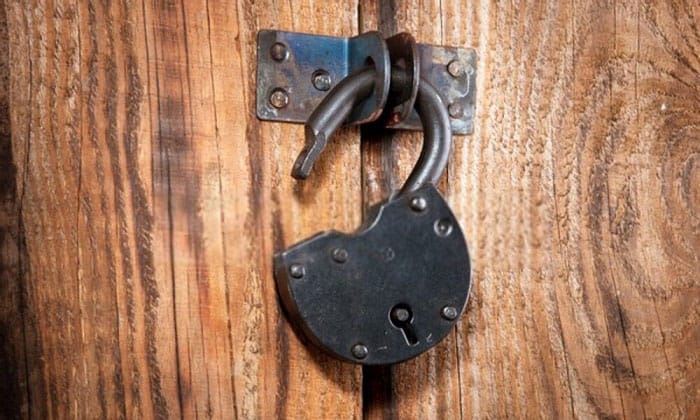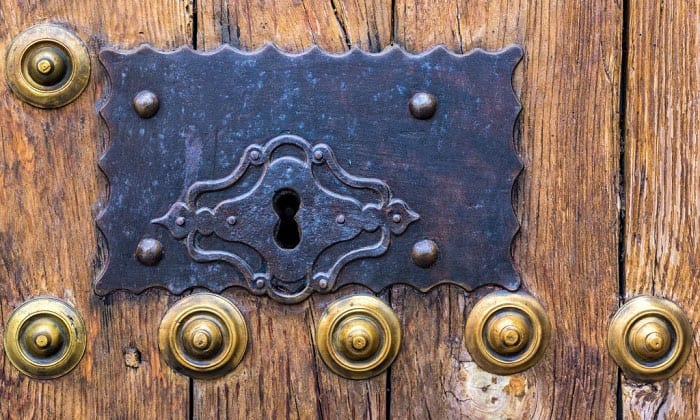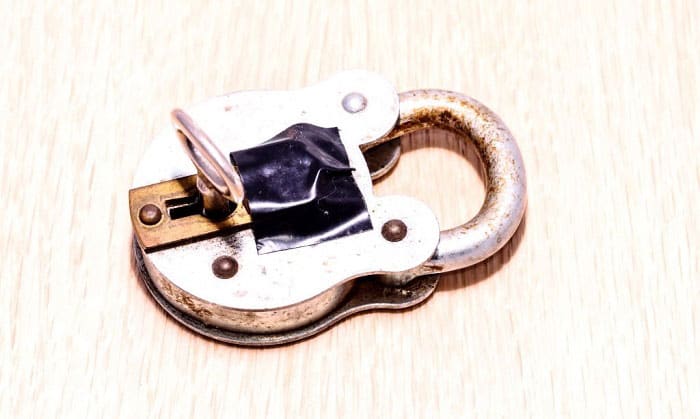Do you want to know how to unlock an antique lock without a key to peek inside the antique chest you purchase?
Although an old lock looks complicated because of its decoration, you can easily pick an antique lock by using household items like a paperclip or a coat hanger.
You don’t need to call a professional locksmith to help you out. The steps on antique lock picking are pretty straightforward. You can finish the whole tutorial in a few minutes.
Table of Contents
Method 1: Using a Coat Hanger
What you need
If the antique lock has a simple locking mechanism, you can use this household item to open it.
Coat hanger/Metal paper clip/Bobby pin – The coat hanger must be made of metal. It must also be malleable so that you can easily bend it.
If no coat hanger is available, you can also use a metal paperclip or a bobby pin. However, you need to strip off the plastic cover to pick the lock smoothly. It must also be sturdy so that you can apply pressure on it without breaking and bending it.
Step 1: Make a hook-like tool by straightening the curved end of the coat hanger and bending its tip.
If you are dealing with a small lock, you just have to straighten the curved end of the coat hanger.
However, if it’s a large one, you need to make a hook-like tool by bending ¼ of the straightened end to a 90-degree angle.
Make sure that there is enough space to grip the DIY tool.
Step 2: Insert the makeshift tool inside the keyhole and turn it like a key.
Once you are finished making a makeshift tool, insert it inside the keyhole of the antique lock.
To locate the lever, look for the spot where you feel a little resistance. After finding it, turn the tool like you turn a key. Don’t put too much force since you may end up damaging the antique lock.
Method 2: Using a Flat Head Screwdriver
What you need
If picking the lock using a coat hanger doesn’t work, you can use a sturdier tool to open a skeleton key lock without a key. This item is also useful in unlocking complicated antique locks.
Flathead screwdriver/ Nail file- The flathead screwdriver must be small enough to fit inside the lock’s keyhole. If you are not sure what size to use, having a set of flathead screwdrivers with various sizes will help you decide immediately.
A good alternative for a flat head screwdriver is a nail file. However, it must have a curved end so that it can open the lock. Aside from that, it must be small enough to fit the keyhole.
Step 1: Insert the flat head screwdriver inside the keyhole.
First, you need to make sure that the flat head screwdriver will fit inside the keyhole. If it’s too large, it may get stuck inside. As much as possible, it must not touch the curves of the keyhole.
If you already have the right tool that could perfectly fit, insert it inside the keyhole.
Step 2: Locate the lever and turn the flat head screwdriver.
Once the flat head screwdriver is positioned inside the lock, look for the lever. It is the mechanism that pushes back.
Next, apply the right force into it, then turn the flat head screwdriver in the direction you turn a key. After doing this, the lock will automatically open.
Method 3: Using an Allen Wrench
What you need
To open a deadbolt antique lock, this item is the best tool that you can use.
Allen wrench – You need two Allen wrenches to open the lock. You can use 3/32 inches if the keyhole has a normal size. However, if it is smaller, you need smaller sizes for the Allen wrenches.
Make sure that two Allen wrenches can fit inside the keyhole of the lock.
Step 1: Insert the first Allen wrench at the top of the keyhole to push the lever
If you need to open a deadbolt skeleton lock, you will need an Allen wrench. Insert the first Allen wrench at the top of the keyhole.
Now, look for the lever and push it using the right amount of pressure. You need to keep the pressure on the lever until you open the lock.
Step 2: Insert the second Allen wrench inside the keyhole.
After you have positioned the first Allen wrench, insert the second one inside the keyhole of the lock. It must be hooked to the first Allen wrench.
If they cannot fit inside the keyhole, you may use smaller ones or a thin metal wire as an alternative to your second wrench.
Step 3: Turn the second Allen wrench clockwise.
Position the second Allen wrench in a way that it could push the deadbolt lock if turned.
After you have positioned it, keep it hooked on the first wrench, then turn it clockwise. Keep turning it until the lock opens. After that, remove the Allen wrenches inside the keyhole.
Frequently Asked Questions
1. How can I open an antique Chinese lock without a key?
You can open a antique chinese lock without key using a coat hanger, flat head screwdriver, or Allen wrenches. Check the methods above and choose the one that will work best for you.
2. Can a locksmith provide me with a matching key for the antique lock?
Yes, a professional locksmith can provide you with a matching key. If you still have your damaged lock, you can bring it to him so that he can take a look and provide you with a key that would match your antique lock. If you lost the key, you could also give him some pictures of the lock as his reference.
Conclusion
Did you find our tutorial on how to unlock an antique lock without a key useful? Through this tutorial, you can now find out what is inside the antique chest you purchased or inherited from an older relative. The steps are easy to follow, and you don’t need to call for professional help.
If you know friends or relatives who also want to unlock an antique chest or furniture, you can share this post with them. We also want to know what method you use to open the antique lock. Leave a comment below.

I am the last member to join Revolar and might be just the luckiest to work with dedicated people like Teddy and John. Our team has established a process where my only job is writing the best content to deliver incredible ideas and guides.





